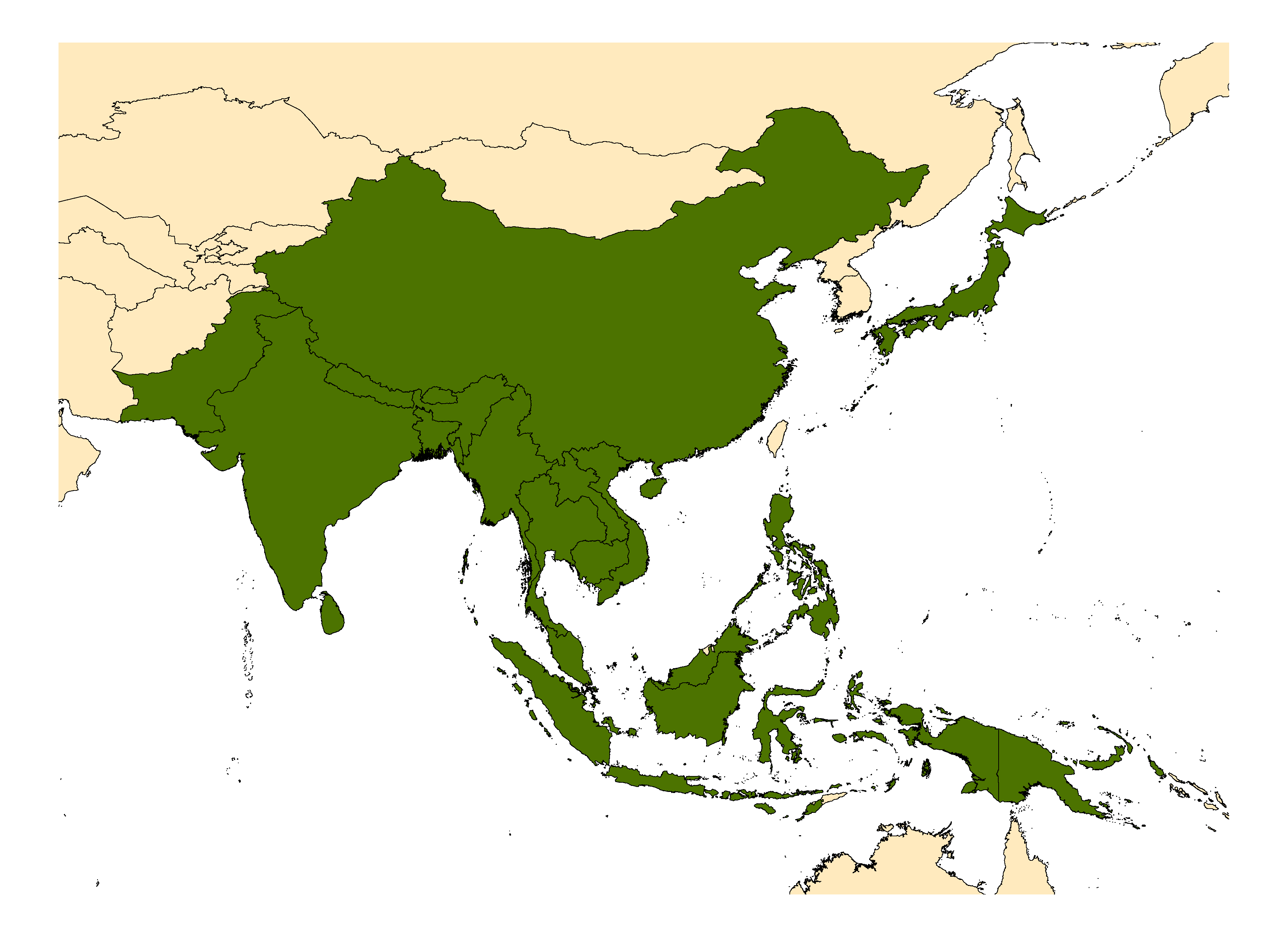INDO-ORIENTAL REGION
Etymology: not stated [snow, snowy (L)]
Despite being a tropical species, Aedes niveus was named after the Latin name for snow, in reference to the heavy dusting of white scales adorning the top of its scutum. Originally described based on specimens from Oras, Samar in the Philippines, Aedes niveus s.s. is known only to occur from the islands of the Philippine archipelago. Aedes niveus is the nominotypical member of the Niveus Group—widely distributed from Pakistan to New Guinea—which comprises dozens of closely related species, mainly identifiable only by characters of the male genitalia. The Niveus Group comprises mainly zoophilic species but some, including Ae. niveus, are important vectors. Aedes albolateralis (Theobald) is a competent vector of dengue virus, being almost as susceptible to DEN-2 as Ae. albopictus (Skuse), Ae. harinasutai Knight is the principal vector of sub-periodic Wuchereria bancrofti in western Thailand, and Ae. niveus s.l.
Type locality: Oras, Samar, Philippines
Type depository: Natural History Museum, London, England, United Kingdom (NHMUK)
DIAGNOSTIC CHARACTERS (Click photos to view; mouse over and click large photo to zoom in.)
ADULT (illustrated): Thorax: Paratergite without scales; postpronotum without broad white scales; scutum with anterior half conspicuously pale-scaled. Legs: Ta-I–III all dark; Fe-II without silvery spot in middle of anterior surface; Fe-III with apical dark area for ≥0.25 segment.
LARVA (not illustrated): Terminal segments: Seta 4-X with 5 pairs of setae; precratal setae present; comb with comb scales not on sclerotized plate.
TAXONOMIC KEYS
None
![]()
WRBU – Aedes – Australasian Region – Larva
![]()
WRBU – Aedes – Indomalayan Region – Adult
![]()
WRBU – Aedes – Indomalayan Region – Larva
![]()
WRBU – Aedes – Oriental Region – Adult
![]()
WRBU – Aedes – Oriental Region – Larva
Exemplar DNA sequences
Ae. niveus COI: KY817567
BIONOMICS
Immatures
Tree holes are the typical immature habitats of Aedes niveus s.s.
Adults
Female Aedes niveus s.s. are day biters. Although primarily zoophilic, they do bite humans and the species is an important vector of periodic Wuchereria bancrofti filariasis in the Philippines. Aedes niveus s.l. are thought to play a significant role in the sylvatic dengue cycle in Borneo.
DISTRIBUTION NOTES
Ae. niveus s.s. : Philippines
Ae. niveus s.l. : Bangladesh, India (includes Andaman Islands), Indonesia (Java, Flores, Timor), Japan, Laos, Malaysia, Pakistan, People's Republic of China, Philippines, Singapore, Sri Lanka, Thailand, Vietnam.

WRBU VECTOR HAZARD REPORTS
None; View other WRBU Vector Hazard Reports
Available GIS Models:
IMPORTANT REFERENCES (full citations below)
Ludlow 1903: 139 (F; as Stegomyia nivea)
Barraud 1923g (M*, F*)
Feng 1938: 512 (M*, F*, L*)
Knight 1946: 278 (M*, F, L*)
Knight & Chamberlain 1948, Fig. 33 (P*)
Knight & Hull 1951b: 246 (M, F, L*; taxonomy)
Basio 1971b: 17 (M*; bionomics)
Aslamkhan 1971b (distribution; Pakistan)
Lu 1981 (taxonomy; sensu lato)
Ahmed 1987 (distribution; Bangladesh)
Tewari & Hiriyan 1995: 167 (M*, F, P*, L*)
Huang & Rueda 1998: 824 (F*; type information)
Reinert 2002e: Fig. 8 (F*)
Reinert et al. 2006 (phylogenetics, classification, taxonomy)
Reinert & Harbach 2006 (F)
Reinert 2008h: Fig. 1 (F*)
CURRENT SYNONYMS
None
CURRENT SUBSPECIES
None
CITED REFERENCES
Ahmed, T.U. (1987). Checklist of the mosquitoes of Bangladesh. Mosquito Systematics, 19(3), 187–200.
Aslamkhan, M. (1971b). The mosquitoes of Pakistan I. A checklist. Mosquito Systematics, 3(4), 147–159.
Barraud, P. J. (1923g). A revision of the Culicine Mosquitoes of India. Part VII. The larvae of some species of Stegomyia; the larvae of some species of Finlaya; the larva of Christophersiomyia thomsoni; the larva of Mimomyia chamberlaini; the larva of Aedomyia catasticta. Indian Journal of Medical Research (Calcutta), 11(2), 495–505.
Basio, R. G. (1971b). The mosquito fauna of the Philippines (Diptera, Culicidae). Manila: National Museum of the Philippines. 198pp.
Feng, L.C. (1938). The tree hole species of mosquitoes of Peiping, China. Chinese Medical Journal (Suppl. 2), 503–525.
Huang, Y.-M., & Rueda, L.M. (1998). Description of a paralectotype female of Aedes (Finlaya) niveus (Ludlow) (Diptera: Culicidae). Proceedings of the Entomological Society of Washington, 100(4), 824–827.
Knight, K.L. (1946). The Aedes (Finlaya) niveus subgroup of Oriental mosquitoes. Journal of the Washington Academy of Sciences, 36, 270–280.
Knight, K.L., & Chamberlain, R.W. (1948). A new nomenclature for the chaetotaxy of the mosquito pupa, based on a comparative study of the genera (Diptera: Culicidae). Proceedings of the Helminthological Society of Washington, 15, 1–18.
Knight, K.L., & Hull, W.B. (1951b). The Aedes mosquitoes of the Philippine Islands I. Keys to species. Subgenera Mucidus, Ochlerotatus, and Finlaya (Diptera, Culicidae). Pacific Science, 5, 211–251.
Lu, B.-L. (1981). The Aedes niveus group of China (Diptera: Culicidae). Entomotaxonomia, 3(4), 255–263.
Ludlow, C.S. (1903). Some Philippine mosquitoes. Journal of the New York Entomological Society, 11, 137–144.
Reinert, J.F. (2002e). Comparative anatomy of the female genitalia of genera and subgenera in tribe aedini (Diptera: Culicidae). Part XIII. Genus Ochlerotatus Lynch Arribalzaga. Contributions of the American Entomological Institute, 33(1), 1–111.
Reinert, J.F. (2008h). Comparative anatomy of the female genitalia of generic-level taxa in tribe Aedini (Diptera: Culicidae). Part XXII. Genus Downsiomyia Vargas. Contributions of the American Entomological Institute, 35(3), 29–37.
Reinert, J.F., & Harbach, R.E. (2006). Description of genus Downsiomyia Vargas (Diptera: Culicidae: Aedini) and its type species Do. nivea (Ludlow). Zootaxa, 1196, 33–61.
Reinert, J.F., Harbach, R.E., & Kitching, I.J. (2006). Phylogeny and classification of Finlaya and allied taxa (Diptera: Culicidae: Aedini) based on morphological data from all life stages. Zoological Journal of the Linnaean Society, 148(1), 1–101.
Tewari, S.C., & Hiriyan, J. (1995). Description of Aedes (Finlaya) niveus (Diptera: Culicidae) from Andaman and Nicobar, India. Mosquito Systematics, 27(3), 167–176.
CITE THIS PAGE
Walter Reed Biosystematics Unit (Year). Aedes niveus species page. Walter Reed Biosystematics Unit Website, http://wrbu.si.edu/vectorspecies/mosquitoes/niveus, accessed on [date (e.g. 03 February 2020) when you last viewed the site].








































































































































































